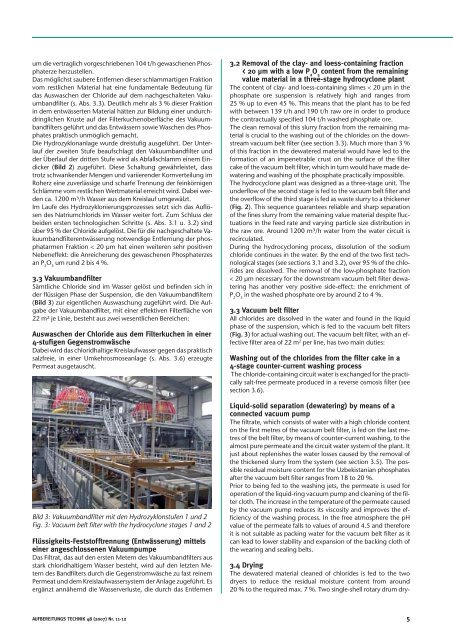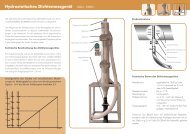Industrielles Auswaschen von Chloriden aus Phosphaterzen unter ...
Industrielles Auswaschen von Chloriden aus Phosphaterzen unter ...
Industrielles Auswaschen von Chloriden aus Phosphaterzen unter ...
Sie wollen auch ein ePaper? Erhöhen Sie die Reichweite Ihrer Titel.
YUMPU macht aus Druck-PDFs automatisch weboptimierte ePaper, die Google liebt.
um die vertraglich vorgeschriebenen 104 t/h gewaschenen Phosphaterze<br />
herzustellen.<br />
Das möglichst saubere Entfernen dieser schlammartigen Fraktion<br />
vom restlichen Material hat eine fundamentale Bedeutung für<br />
das <strong>Auswaschen</strong> der Chloride auf dem nachgeschalteten Vakuumbandfi<br />
lter (s. Abs. 3.3). Deutlich mehr als 3 % dieser Fraktion<br />
in dem entwässerten Material hätten zur Bildung einer undurchdringlichen<br />
Kruste auf der Filterkuchenoberfl äche des Vakuumbandfi<br />
lters geführt und das Entwässern sowie Waschen des Phosphates<br />
praktisch unmöglich gemacht.<br />
Die Hydrozyklonanlage wurde dreistufi g <strong>aus</strong>geführt. Der Unterlauf<br />
der zweiten Stufe beaufschlagt den Vakuumbandfi lter und<br />
der Überlauf der dritten Stufe wird als Abfallschlamm einem Eindicker<br />
(Bild 2) zugeführt. Diese Schaltung gewährleistet, dass<br />
trotz schwankender Mengen und variierender Kornverteilung im<br />
Roherz eine zuverlässige und scharfe Trennung der feinkörnigen<br />
Schlämme vom restlichen Wertmaterial erreicht wird. Dabei werden<br />
ca. 1200 m³/h Wasser <strong>aus</strong> dem Kreislauf umgewälzt.<br />
Im Laufe des Hydrozyklonierungsprozesses setzt sich das Aufl ösen<br />
des Natriumchlorids im Wasser weiter fort. Zum Schluss der<br />
beiden ersten technologischen Schritte (s. Abs. 3.1 u. 3.2) sind<br />
über 95 % der Chloride aufgelöst. Die für die nachgeschaltete Vakuumbandfi<br />
lterentwässerung notwendige Entfernung der phosphatarmen<br />
Fraktion < 20 µm hat einen weiteren sehr positiven<br />
Nebeneffekt: die Anreicherung des gewaschenen Phosphaterzes<br />
an P 2 O 5 um rund 2 bis 4 %.<br />
3.3 Vakuumbandfi lter<br />
Sämtliche Chloride sind im Wasser gelöst und befi nden sich in<br />
der fl üssigen Phase der Suspension, die den Vakuumbandfi ltern<br />
(Bild 3) zur eigentlichen Auswaschung zugeführt wird. Die Aufgabe<br />
der Vakuumbandfi lter, mit einer effektiven Filterfl äche <strong>von</strong><br />
22 m² je Linie, besteht <strong>aus</strong> zwei wesentlichen Bereichen:<br />
<strong>Auswaschen</strong> der Chloride <strong>aus</strong> dem Filterkuchen in einer<br />
4-stufi gen Gegenstromwäsche<br />
Dabei wird das chloridhaltige Kreislaufwasser gegen das praktisch<br />
salzfreie, in einer Umkehrosmoseanlage (s. Abs. 3.6) erzeugte<br />
Permeat <strong>aus</strong>get<strong>aus</strong>cht.<br />
Bild 3: Vakuumbandfi lter mit den Hydrozyklonstufen 1 und 2<br />
Fig. 3: Vacuum belt fi lter with the hydrocyclone stages 1 and 2<br />
Flüssigkeits-Feststofftrennung (Entwässerung) mittels<br />
einer angeschlossenen Vakuumpumpe<br />
Das Filtrat, das auf den ersten Metern des Vakuumbandfi lters <strong>aus</strong><br />
stark chloridhaltigem Wasser besteht, wird auf den letzten Metern<br />
des Bandfi lters durch die Gegenstromwäsche zu fast reinem<br />
Permeat und dem Kreislaufwassersystem der Anlage zugeführt. Es<br />
ergänzt annähernd die Wasserverluste, die durch das Entfernen<br />
3.2 Removal of the clay- and loess-containing fraction<br />
< 20 µm with a low P 2 O 5 content from the remaining<br />
value material in a three-stage hydrocyclone plant<br />
The content of clay- and loess-containing slimes < 20 µm in the<br />
phosphate ore suspension is relatively high and ranges from<br />
25 % up to even 45 %. This means that the plant has to be fed<br />
with between 139 t/h and 190 t/h raw ore in order to produce<br />
the contractually specifi ed 104 t/h washed phosphate ore.<br />
The clean removal of this slurry fraction from the remaining material<br />
is crucial to the washing out of the chlorides on the downstream<br />
vacuum belt fi lter (see section 3.3). Much more than 3 %<br />
of this fraction in the dewatered material would have led to the<br />
formation of an impenetrable crust on the surface of the fi lter<br />
cake of the vacuum belt fi lter, which in turn would have made dewatering<br />
and washing of the phosphate practically impossible.<br />
The hydrocyclone plant was designed as a three-stage unit. The<br />
underfl ow of the second stage is fed to the vacuum belt fi lter and<br />
the overfl ow of the third stage is fed as waste slurry to a thickener<br />
(Fig. 2). This sequence guarantees reliable and sharp separation<br />
of the fi nes slurry from the remaining value material despite fl uctuations<br />
in the feed rate and varying particle size distribution in<br />
the raw ore. Around 1200 m³/h water from the water circuit is<br />
recirculated.<br />
During the hydrocycloning process, dissolution of the sodium<br />
chloride continues in the water. By the end of the two fi rst technological<br />
stages (see sections 3.1 and 3.2), over 95 % of the chlorides<br />
are dissolved. The removal of the low-phosphate fraction<br />
< 20 µm necessary for the downstream vacuum belt fi lter dewatering<br />
has another very positive side-effect: the enrichment of<br />
P 2 O 5 in the washed phosphate ore by around 2 to 4 %.<br />
3.3 Vacuum belt fi lter<br />
All chlorides are dissolved in the water and found in the liquid<br />
phase of the suspension, which is fed to the vacuum belt fi lters<br />
(Fig. 3) for actual washing out. The vacuum belt fi lter, with an effective<br />
fi lter area of 22 m 2 per line, has two main duties:<br />
Washing out of the chlorides from the fi lter cake in a<br />
4-stage co<strong>unter</strong>-current washing process<br />
The chloride-containing circuit water is exchanged for the practically<br />
salt-free permeate produced in a reverse osmosis fi lter (see<br />
section 3.6).<br />
Liquid-solid separation (dewatering) by means of a<br />
connected vacuum pump<br />
The fi ltrate, which consists of water with a high chloride content<br />
on the fi rst metres of the vacuum belt fi lter, is fed on the last metres<br />
of the belt fi lter, by means of co<strong>unter</strong>-current washing, to the<br />
almost pure permeate and the circuit water system of the plant. It<br />
just about replenishes the water losses c<strong>aus</strong>ed by the removal of<br />
the thickened slurry from the system (see section 3.5). The possible<br />
residual moisture content for the Uzbekistanian phosphates<br />
after the vacuum belt fi lter ranges from 18 to 20 %.<br />
Prior to being fed to the washing jets, the permeate is used for<br />
operation of the liquid-ring vacuum pump and cleaning of the fi lter<br />
cloth. The increase in the temperature of the permeate c<strong>aus</strong>ed<br />
by the vacuum pump reduces its viscosity and improves the effi<br />
ciency of the washing process. In the free atmosphere the pH<br />
value of the permeate falls to values of around 4.5 and therefore<br />
it is not suitable as packing water for the vacuum belt fi lter as it<br />
can lead to lower stability and expansion of the backing cloth of<br />
the wearing and sealing belts.<br />
3.4 Drying<br />
The dewatered material cleaned of chlorides is fed to the two<br />
dryers to reduce the residual moisture content from around<br />
20 % to the required max. 7 %. Two single-shell rotary drum dry-<br />
AUFBEREITUNGS TECHNIK 48 (2007) Nr. 11-12 5



